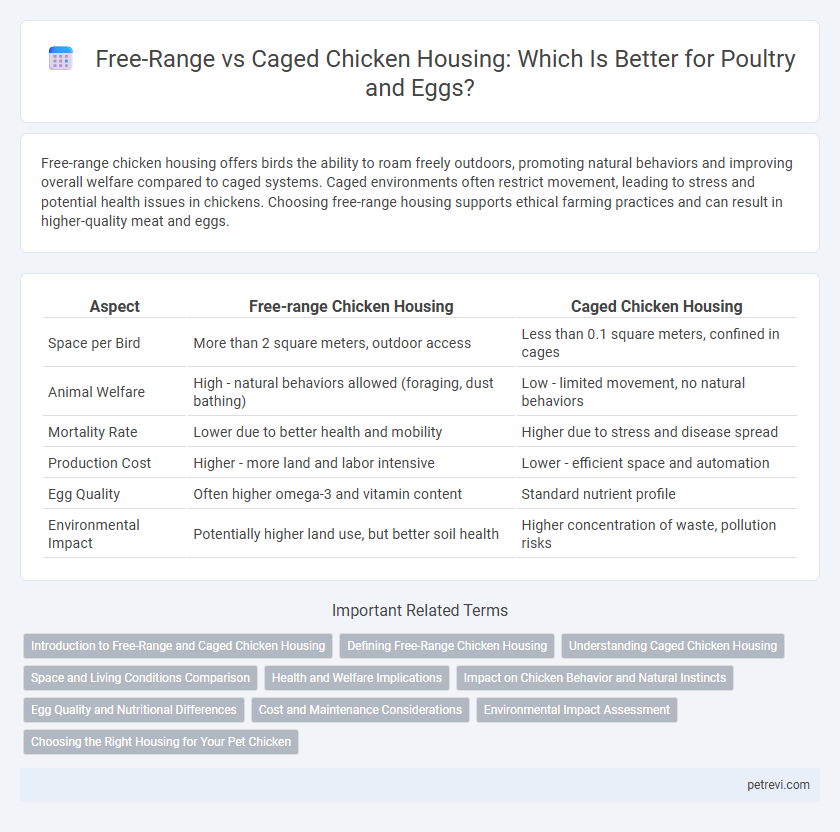Free-range chicken housing offers birds the ability to roam freely outdoors, promoting natural behaviors and improving overall welfare compared to caged systems. Caged environments often restrict movement, leading to stress and potential health issues in chickens. Choosing free-range housing supports ethical farming practices and can result in higher-quality meat and eggs.
Table of Comparison
| Aspect | Free-range Chicken Housing | Caged Chicken Housing |
|---|---|---|
| Space per Bird | More than 2 square meters, outdoor access | Less than 0.1 square meters, confined in cages |
| Animal Welfare | High - natural behaviors allowed (foraging, dust bathing) | Low - limited movement, no natural behaviors |
| Mortality Rate | Lower due to better health and mobility | Higher due to stress and disease spread |
| Production Cost | Higher - more land and labor intensive | Lower - efficient space and automation |
| Egg Quality | Often higher omega-3 and vitamin content | Standard nutrient profile |
| Environmental Impact | Potentially higher land use, but better soil health | Higher concentration of waste, pollution risks |
Introduction to Free-Range and Caged Chicken Housing
Free-range chicken housing allows birds to roam outdoors in open spaces, promoting natural behaviors and access to fresh air and sunlight, which enhances animal welfare and can improve meat and egg quality. Caged chicken housing confines birds in controlled indoor environments, maximizing space efficiency and production but often raising concerns about animal welfare due to limited movement and natural behavior restriction. Understanding the differences in housing systems is crucial for optimizing poultry health, productivity, and ethical farming practices.
Defining Free-Range Chicken Housing
Free-range chicken housing allows birds to roam outdoors with access to natural light, fresh air, and soil, enabling behaviors like foraging, dust bathing, and social interaction. This system contrasts with caged environments by promoting animal welfare and reducing stress-related issues. Free-range housing also supports organic and sustainable farming practices, contributing to higher-quality poultry products.
Understanding Caged Chicken Housing
Caged chicken housing confines birds to small, enclosed spaces, limiting their movement and natural behaviors, which can lead to stress and health issues. This method allows for high-density stocking and easier management but raises concerns about animal welfare and quality of meat and eggs. Understanding the environmental conditions, ventilation, and hygiene practices in caged systems is essential for addressing the challenges associated with this type of poultry housing.
Space and Living Conditions Comparison
Free-range chickens have significantly more space to move, typically ranging from 2 to 5 square feet per bird indoors and access to outdoor areas, promoting natural behaviors and better welfare. Caged chickens are confined to about 67 to 86 square inches each in conventional battery cages, limiting movement and contributing to stress and health issues. The enhanced space and varied environment in free-range systems improve muscle tone and reduce disease risk compared to the cramped, restrictive conditions of caged housing.
Health and Welfare Implications
Free-range chicken housing promotes better health outcomes by allowing natural behaviors such as foraging and exercise, which reduces stress and improves immune function. In contrast, caged systems often lead to higher incidences of respiratory issues, feather pecking, and bone deformities due to limited movement and poor air quality. Welfare implications favor free-range systems by enhancing mental stimulation and reducing physical ailments inherent in confined, overcrowded cages.
Impact on Chicken Behavior and Natural Instincts
Free-range chicken housing allows birds to express natural behaviors such as foraging, dust bathing, and scratching, promoting better mental and physical health compared to caged systems. Caged environments restrict movement and inhibit instinctual activities, often leading to increased stress and abnormal behaviors like feather pecking. Studies show that free-range conditions enhance welfare by enabling chickens to engage in innate behaviors essential for their well-being.
Egg Quality and Nutritional Differences
Free-range chickens typically produce eggs with higher omega-3 fatty acids, vitamins A and E, and beta-carotene compared to caged chickens, due to their diverse diet and increased exercise. Eggs from caged hens often show lower nutrient density and can have thinner shells resulting from limited movement and stress. Studies highlight that free-range egg quality can positively impact consumer health by providing enhanced nutritional benefits.
Cost and Maintenance Considerations
Free-range chicken housing typically incurs higher initial setup costs due to the need for larger outdoor spaces and secure fencing, whereas caged systems require less land and simpler infrastructure, reducing upfront expenses. Maintenance for free-range chickens involves increased labor for pasture management and predator control compared to the more controlled environment of caged housing, which simplifies cleaning and health monitoring. Operational costs in free-range systems can be higher long-term due to variable feed intake and environmental exposure, while caged systems benefit from efficiency in feed usage and automated waste removal.
Environmental Impact Assessment
Free-range chicken housing reduces environmental impact by promoting natural foraging, which helps maintain soil health and supports biodiversity. Caged systems concentrate waste in confined areas, increasing the risk of soil and water contamination due to nutrient runoff and limited microbial breakdown. Studies show free-range setups lower greenhouse gas emissions through enhanced carbon sequestration in pasture lands compared to conventional caged operations.
Choosing the Right Housing for Your Pet Chicken
Choosing the right housing for your pet chicken involves weighing the benefits of free-range versus caged environments. Free-range housing promotes natural behaviors, improved air quality, and access to varied nutrition, enhancing overall chicken health and welfare. Conversely, caged housing offers better protection from predators and disease but may limit movement and increase stress, impacting long-term well-being.
Free-range vs Caged for Chicken Housing Infographic

 petrevi.com
petrevi.com